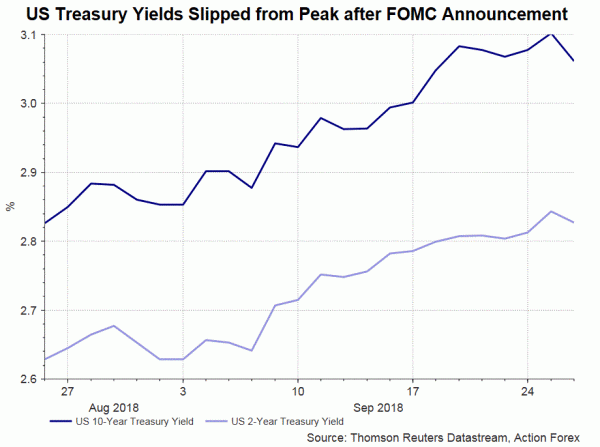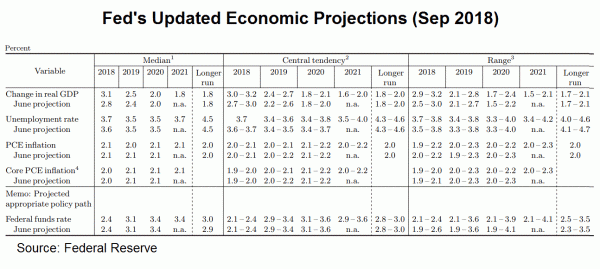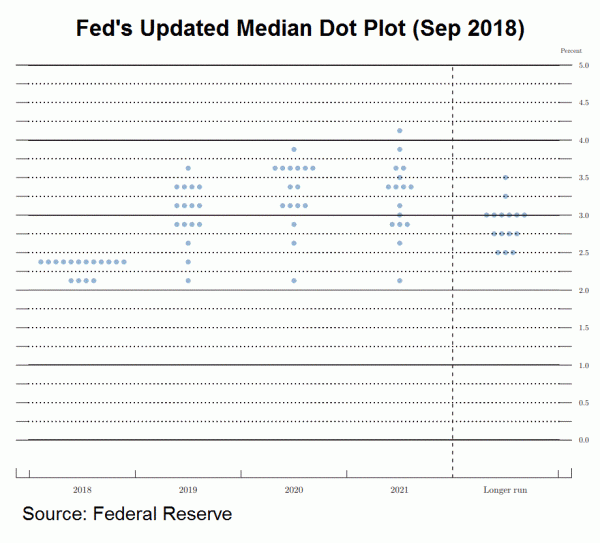FOMC raised the Fed funds rate, by +25 bps, to 2-2.25% in September. While the accompanying statement was largely dubbed from the previous meeting, the market has viewed the removal of the “accommodative” policy language has slightly dovish. This is evidenced in the instant drop of Treasury yields and US dollar’s weakness against the euro. We are not surprised by the removal of the reference. Indeed, the members have, over previous meetings, called for an adjustment in the statement language. They believe that, after a number of interest rate increases since December 2015, describing the current policy as “accommodative” is no longer appropriate.
 The staff economic projections and the updated median dot plot appear more optimistic that in the previous meeting, though. The median projections for real GDP growth were upgraded to +3.1% (from +2.8%) in 2018, and to +2.5% (from +2.4%) in 2019. The forecast for 2020 was unchanged at +2%. The Fed introduced the projection for 2021, which is +1.8% and the same as the “longer run” projection.
The staff economic projections and the updated median dot plot appear more optimistic that in the previous meeting, though. The median projections for real GDP growth were upgraded to +3.1% (from +2.8%) in 2018, and to +2.5% (from +2.4%) in 2019. The forecast for 2020 was unchanged at +2%. The Fed introduced the projection for 2021, which is +1.8% and the same as the “longer run” projection.
The median unemployment rate forecast was revised slightly higher to 3.7% (from 3.6% previously) in 2018, but stayed unchanged at 3.5% for 2019 and 2020. The unemployment rate is expected to increase to 3.7% in 2021 and to 4.5% in the longer run.
The median estimate for core PCE was is expected to reach +2.0% (unchanged) in 2018, and then rise to 2.1% and stay there still 2021.
On the policy rate outlook, the median expectation for the Fed funds rate was unchanged throughout the projection horizon, with one more hike this year, followed by 3 hikes in 2019 and 1 in 2020. That is, median dot for the policy rate is 3.1% by end of 2019 and 3.4% by end- 2020. The longer-run neutral rate is projected to be 3.0%. There appears to be some upside risk to hikes in 2020, as 7 members expect more than one hike next year.
The policy statement was largely the same as the previous one with one major change – removal of the reference that “The stance of monetary policy remains accommodative, thereby supporting strong labor market conditions and a sustained return to +2% inflation”. The market views this as slightly dovish – as Fed sees the policy as less accommodative, it might be approaching the end of the rate hike cycle. However, Powell assured that the adjustment does not imply a change in Fed’s gradual monetary policy path. We do not find the adjustment surprising at all. Indeed, the members have, over past meetings, called for an adjustment in the statement language. They believe that, after a number of interest rate increases since December 2015, describing the current policy as “accommodative” is no longer appropriate.














